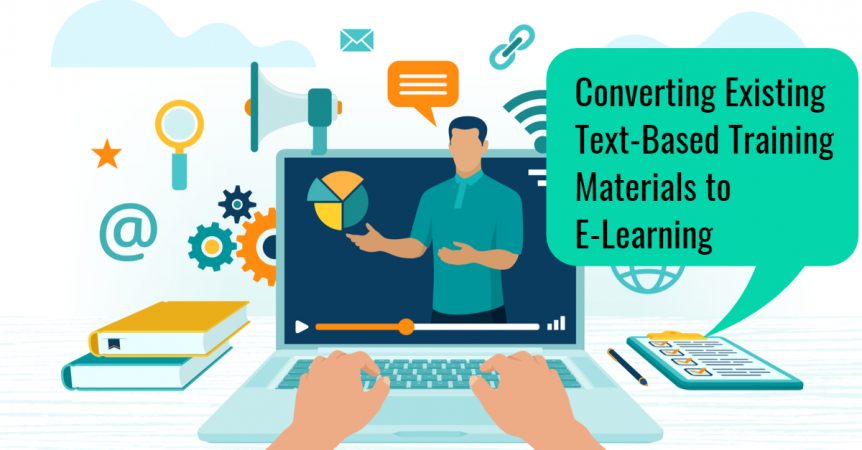Converting Existing Text-Based Training Materials to E-Learning
Many organisations in the UAE and Saudi Arabia have text-based training materials in their library of content. Does this apply to your organisation? Do you want to improve your text-based training materials by converting them to e-learning?
The good news is that you can convert almost any text-based training content into e-learning. This includes guides, manuals, PowerPoint presentations, process documents, and more.
However, you shouldn’t just copy your existing content into an e-learning course template, as you will only make marginal improvements on what you already have.
The following five-step process will ensure you get the best results when converting existing text-based training content to e-learning.
Step 1: Audit What You Have and Assess What is Relevant
Start by auditing the material you have at the moment, gathering everything together to assess whether it is still relevant and useful. When doing this, consider whether it would be more efficient to start again from scratch, as this could be the better approach if the existing training material is considerably outdated. Getting everything together in an audit will also ensure nothing is missed.
Step 2: Align Objectives Then and Now
The temptation at this point is to dive into converting the content into e-learning straightaway. However, one of the most important steps when creating an e-learning course is to define your objectives. This still applies when converting existing text-based training materials to e-learning.
So, consider what the objectives were when the existing training material was first created. Do those objectives align with your objectives today? If they don’t, you might need to make more adjustments to the existing content than originally planned.
Step 3: Split Up Topics Where It Makes Sense to Do So
Some types of text-based training materials can be quite long. A good example is a training manual. With this type of content, it is often better to split up the topics to create multiple e-learning courses. Doing this can improve the learner experience while also making the training course more effective.
Step 4: Review the Content
The next step is to go through the existing content carefully to identify anything that is no longer relevant, out-of-date, incorrect, misleading, or missing. You will then need to update any content that you have identified as being no longer suitable. You may need the help of subject matter experts to complete this part of the process.
You should also look for repeated content in existing text-based training materials. If you have another e-learning training course that covers this repeated content, or you plan to create a new e-learning course, the repeated content can be replaced with a link as supplementary information.
Step 5: Reimagine, Restructure, and Reduce
This is the final step in the process, and it’s also the biggest one. The previous steps were about planning, but this one is about the process of transferring the existing content into an e-learning course.
As mentioned earlier, however, don’t just copy and paste. Transferring text-based content to an e-learning course is an opportunity to make improvements. The three Rs can help with this process: reimagine, restructure, and reduce.
- Reimagine – assess the existing content to consider if there is a better way to present the information. For example, could a large block of text be replaced by an image, or could an image be replaced with a video? Is there a better way to present numbers and statistics, or could an animation be used to explain a complex concept? Another part of the existing training material you can reinvent is examples. These could be replaced by scenarios, turning a passive piece of content into an interactive e-learning element.
- Restructure – the structure of the existing text-based training material might not be optimised in its current form. Reviewing and changing the structure could improve the course and achieve better results. You might also choose to change the structure to make it more suitable for learning online. The reimagining of how you present some of the content in the course could also make it beneficial to restructure the course.
- Reduce – text-based training materials can be very long-winded. However, this sort of content doesn’t work well in a digital format or in e-learning. Therefore, you should take the opportunity of reducing the content when you are transferring it to e-learning. You can change the language to make it more natural and conversational, and you can remove unnecessary repetition. Removing off-topic content is also beneficial, as is removing introductory-type content. Introductory-type content is common in many text-based training materials, but they are largely (if not completely) unnecessary in e-learning.
The end result of the above process should be a streamlined e-learning course with engaging content that facilitates learning and improves the experience of learners.
Benefiting from E-Learning in Your Organisation
For most topics, e-learning offers multiple benefits over other training methods, including text-based training materials. Those benefits include enhanced levels of engagement with the training, improved knowledge retention, and better learner satisfaction. You will also get better results in terms of achieving your objectives.
There is also another big advantage of converting existing text-based training materials into e-learning. That advantage is that you already have a large amount of the content ready to go. You might even have everything you need. This head start means it makes sense to begin making the e-learning switch.
